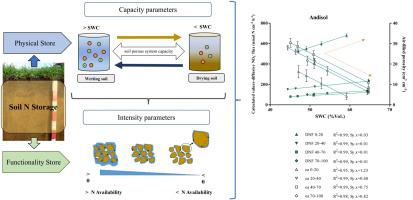Soil and Tillage Research ( IF 6.1 ) Pub Date : 2020-09-30 , DOI: 10.1016/j.still.2020.104802 John Clunes , José Dörner , Dante Pinochet

|
The dynamics of water in the soil permit the movement, storage and redistribution of nitrogen (N) within productive and natural agro-ecosystems. The objective of this research was to determine the functionality of the soil’s porous system, using capacity and intensity parameters in two volcanic soils (Andisol and Ultisol) under agricultural use and to present a new approach of how soils have the capacity to store inorganic N throughout time. Undisturbed soil core samples (230 cm3 and 250 cm3) were collected at four depths: 0–20; 20–40; 40–70; 70–100 cm. Capacity parameters: air capacity (AC) and plant available water (PAW) and intensity parameters: saturated hydraulic conductivity (Ks) and pore connectivity index (C2) were measured and calculated. Greater average PAW (48%) was determined at the previously mentioned depths in the Andisol as compared to the Ultisol (32%). Calculated values-diffusive NO3- fluxes (DNF) as a function of soil water content (SWC) were determined in the pF curve (R2 = 0.98; p < 0.0001; fitted model proposed by Clunes, 2020). As SWC increased in PAW, the DNF did as well (DNF in Andisol, from 480 nmol N cm–2 h–1 to 710 nmol N cm–2 h–1). An inverse relationship was observed between the DNF and the air-filled porosity (ea); the slope was about –1.02 in both soils. The DNF presented a significant relationship with the C2 index in the Andisol (R2 > 0.80; Sy.x > 0.02). In contrast, the Ultisol at the depth of 0–20 cm presented a highly negative relationship between DNF and C2 (R2 = 0.99), due to tillage. The relationship observed here between intensity parameters and DNF revealed a dynamic factor of N availability in the soil. As water increased in PAW and the continuity values between the pores augmented, this allowed for an increase in the available N in a soil volume. We propose that soils have the capacity to physically store inorganic N in the PAW and the functionality of the pore system (their ability to transport water and distribute nutrients throughout the profile). Improving our comprehension in this regard will allow us to increase fertilization efficiency and could also contribute to closing nutrient cycles within an agro-ecosystem.
中文翻译:

孔隙系统的功能性如何影响火山灰土壤中的无机氮存储?
土壤中水分的动态变化使氮(N)在生产性和天然农业生态系统中得以移动,存储和重新分配。这项研究的目的是利用农业使用下的两种火山土壤(Andisol和Ultisol)的容量和强度参数,确定土壤多孔系统的功能,并提出一种新的方法来研究土壤如何在整个土壤中存储无机氮的能力。时间。原状土壤核心样品(230 cm 3和250 cm 3)收集在四个深度:0–20;20-40;40-70;70–100厘米。容量参数:空气容量(AC)和植物有效水(PAW)以及强度参数:饱和水导率(Ks)和孔隙连通性指数(C2)均已测量并计算。与Ultisol(32%)相比,在安迪索尔先前提到的深度确定了更高的平均PAW(48%)。在pF曲线中确定了计算值-扩散NO 3-通量(DNF)与土壤含水量(SWC)的关系(R 2 = 0.98;p <0.0001; Clunes提出的拟合模型,2020)。随着PAW中SWC的增加,DNF的效果也很好(Andisol中的DNF从480 nmol N cm –2 h –1到710 nmol N cm –2 h–1)。在DNF与充气孔隙率(ea)之间观察到反比关系;两种土壤的坡度约为–1.02。DNF与Andisol中的C2指数呈显着关系(R 2 > 0.80; Sy.x> 0.02)。相反,在0–20 cm深度处的Ultisol在DNF与C2(R 2= 0.99),因为耕种。这里观察到的强度参数与DNF之间的关系揭示了土壤中N有效性的动态因素。随着PAW中水的增加和孔之间的连续性值的增加,这使得土壤体积中的有效氮增加。我们建议土壤具有将无机氮物理存储在PAW中的能力和孔隙系统的功能(它们在整个剖面中具有输送水和分配养分的能力)。在这方面提高我们的理解力将使我们能够提高施肥效率,也可能有助于结束农业生态系统中的养分循环。











































 京公网安备 11010802027423号
京公网安备 11010802027423号